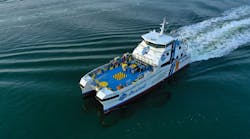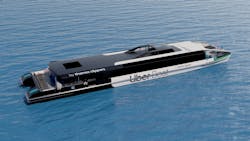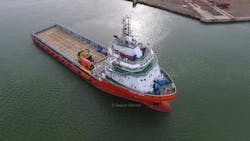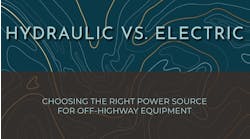Like many industries, the use of hybrid electric power systems is making its way into marine and offshore applications. Hybrid systems which integrate conventional and new technologies—such as a diesel engine and a fuel cell—offer these applications the opportunity to reduce emissions as well as other benefits like reduced noise and maintenance.
The largest driver for the shift to hybrid electric systems is environmental requirements, i.e. reducing emissions, says Gareth Burton, VP of Technology at the American Bureau of Shipping (ABS)—a marine classification society which develops rules to guide design of marine and offshore vessels.
The International Maritime Organization (IMO) adopted a greenhouse gas (GHG) strategy in 2018 which set a target of reducing total annual GHG emissions by at least 50% by 2050 compared to 2008 levels. IMO is also looking to reduce carbon dioxide (CO2) emissions per transport work by 40% by 2030 and by 70% by 2050.
Implementation of hybrid electric power systems will help the industry achieve these targets. Use of such systems can not only help to lower emissions output but also a reliance on fossil fuels. Additional benefits such as those to operational demands are also helping to drive the transition to hybrid power sources. “There’s more flexibility when alternative power sources are used,” says Burton. “Use of alternative sources allows the engines onboard [vessels] to be used less and increase efficiency and operational flexibility of the vessel.”
Industry Goes Hybrid
By pairing another technology, such as fuel cells, with a vessel’s engines, operating range can be extended to make the fuel onboard go further. Depending on the design of the hybrid system, the alternative technology could be used for a period of time before switching to the engine. Or it could supplement power to the engine, reducing its fuel use.
In March 2022, Danfoss Power Solutions’ Editron division announced it would provide components including electric motors for use in two new hybrid high-speed passenger ferries which will operate in central London. The ferries will be able to run on zero-emission electric propulsion and switch to biofuel.
Use of the hybrid powertrain enables the ferries to reduce their environmental impact without sacrificing performance. The ability to switch to use of biofuel will help maintain low emissions while ensuring the ferries can complete their routes. Operating range is often a concern for many when moving to electric powered vehicles, but a hybrid system ensures there is a backup or alternative power capability when needed.
Danfoss notes use of the hybrid system can help to improve comfort for operators and passengers as the ferry is able to run much quieter through use of the electric components. Maintenance is often reduced as well with electrification, as there are fewer moving parts and thus wear and tear is minimized.
On April 28, Danfoss announced the Editron division will also provide the electric drivetrain systems for Aukland, New Zealand’s first fully electric passenger ferries.
In addition, the company has recently expanded its partnership with engine manufacturer Volvo Penta—which has been expanding into hybrid and electric systems in recent years—that will see the companies collaborating on electromobility projects in the marine sector. They have collaborated in the past on hybrid marine vessels and plan to expand their collaborative research and development efforts through the new partnership.
No Single Solution
Various types of hybrid electric systems are under development for marine and offshore applications. In general, Burton says conventional power sources like engines are being paired with newer technologies including
- fuel cells,
- solar panels,
- wind,
- lithium-ion batteries, and
- supercapacitors.
With these technologies, conventional engine power can be supplemented with cleaner power sources. In the case of solar panels and wind, renewable energy can be harnessed to provide power which makes for an especially clean alternative to diesel and other fuels.
Burton says there are many permutations of hybrid electric systems under development for the marine and offshore industry, each of which has its own benefits based on the application requirements. He notes ABS is seeing an increased focus on fuel cells as an alternative energy technology as well as wind propulsion. Battery technology is also gaining ground as a means of energy storage onboard vessels.
Similar to other industries, such as heavy-duty trucking, fuel cells are seen as a potential option for vessels. Hydrogen fuel cells are more energy dense and able to run for longer periods, which benefits their use in larger applications requiring more power and longer run times.
Burton says larger marine vessels have several engines onboard. There is the potential for a fuel cell to supplement and ultimately replace at least one of those engines.
Design an Important Factor
Ensuring the technology being utilized has reached the appropriate level of maturity for the application is a key factor which needs to be taken into account when implementing hybrid electric systems, says Burton. “Along with that are things such as the reliability and durability of the new equipment to make sure it can withstand the rigors of application,” he says.
Integration of new alternative energy technologies with conventional power systems is also a key component says Burton. “Quite often there's an energy management system installed on the vessel to manage the energy from the various sources. Making sure that integration is seamless is critical.
“Last, but not least, there's the personnel aspect of the training, as there's new equipment, new technologies and new procedures introduced,” he says. “Making sure that the crew on board are fully cognizant of that equipment and are fully trained in the application of it is a key aspect.”
As ABS both sets the criteria to which marine and offshore vessels should be designed and evaluates those designs—during development, construction and the life of the vessels—it has published guidance on how to integrate and utilize hybrid power systems in this industry.
Recently published guides from ABS include:
- Hybrid Electric Power Systems for Marine and Offshore Applications
- Practical Considerations for Hybrid Electric Power Systems Onboard Vessels
By following the guidelines set out in these documents, engineering teams can be confident the systems and marine vessels are being designed in accordance with well-established and recognized industry criteria.
Integration of hybrid electric power systems will continue to be an area of design focus for years to come in the marine and offshore industry as it looks to reduce its environmental impact, concludes Burton.




